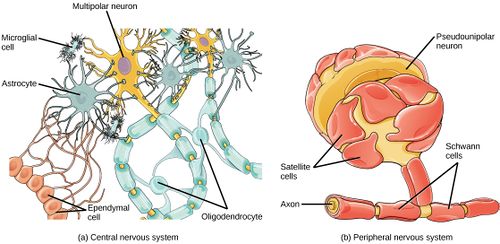Microglia

Microglia is a term that is used to describe the tissue-resident macrophages of the central nervous system. These macrophages were originally classified as glial cells, under the assumption that the cells had a merely structural function, before it was realized that the cells were in fact immune cells. As the tissue-resident sentinel cells of the central nervous system, microglia survey their environment for abnormalities such as infection or tissue damage, and then initiate an immune response to fight the infection or repair the tissue damage.[1]
Microglia Activity[edit | edit source]
Microglia function in multiple capacities:
Apoptosis[edit | edit source]
One of their functions is to clean up the remains of a cell after it has apoptosed (self induction of cell death). This is important because the contents of a cell can be harmful when not contained by cell or organelle membranes. The microglia when activated takes on a blob-like structure and ingests the dead cell and its contents. Microglia can also prompt cells to become apoptotic.[citation needed]
Neural Pruning[edit | edit source]
Microglia also prune neurons at the synapses, which are the spaces between neurons across which neurotransmitters travel. If these are damaged, dysfunctional or underused microglia will repair or remove the problem area. This function of microglia is important to development but may become harmful during neuroinflammatory events. During inflammation of the brain, the microglia may prune too much causing a loss of synaptic integrity.
Priming and Microglia Activation[edit | edit source]
Several events can cause microglia to become primed.[2] Priming means that microglia will respond more aggressively and more easily to activating factors, and occurs when the microglia are over-exposed to harmful events or stimuli. One of the events that can prime microglia is aging. Usually, cells in the body are continuously recycled and regenerated so that they function like new. Microglia are not replaced often, however, and can wear from use.
Infections can also cause microglial priming. During an infection, immune molecules called cytokines circulate throughout the body. Some of these molecules can get directly into the brain and activate microglia, or they can indirectly activate microglia through neural signaling of the vagus nerve. If an infection persists for an extended period of time, microglia will continuously be activated and may become damaged from use.
Traumatic brain injuries also prime microglia. Direct damage to the brain (e.g. concussion, stroke or blunt force trauma) causes the microglia to work continuously to resolve the damage. The damage itself also causes the release of inflammatory markers that activate the microglia. Continued functioning can cause persistent symptoms of the initial damage.
Notable studies[edit | edit source]
- 2019, Evidence of widespread metabolite abnormalities in Myalgic encephalomyelitis/chronic fatigue syndrome: assessment with whole-brain magnetic resonance spectroscopy
- 2019, Hyperactivation of proprioceptors induces microglia-mediated long-lasting pain in a rat model of chronic fatigue syndrome[3] (Full text)
See also[edit | edit source]
- Macrophage
- Glial cell
- Nervous system
- Alzheimer's
- Dorsal root ganglia
- Jarred Younger
- Low dose naltrexone
Learn more[edit | edit source]
- Cell Motility of Microglia Cultured in TIC by Cell Press via YouTube
- Depletion of microglia and inhibition of exosome synthesis halt tau propagation by Research Square via YouTube
- 2-Minute Neuroscience: Glial Cells by Neuroscientifically Challenged via YouTube
- February 21, 2018 - Microglia in Fibromyalgia and Chronic Fatigue Syndrome by Adrienne Dellwo for Very Well Health
References[edit | edit source]
- ↑ Aguzzi, Adriano; Barres, Ben A.; Bennett, Mariko L. (January 11, 2013). "Microglia: Scapegoat, Saboteur, or Something Else?". Science (New York, N.Y.). 339 (6116): 156–161. doi:10.1126/science.1227901. ISSN 0036-8075. PMC 4431634. PMID 23307732.
- ↑ Norden, Diana M.; Muccigrosso, Megan M.; Godbout, Jonathan P. (September 2015). "Microglial priming and enhanced reactivity to secondary insult in aging, and traumatic CNS injury, and neurodegenerative disease". Neuropharmacology. 96: 29–41. doi:10.1016/j.neuropharm.2014.10.028. PMC 4430467. PMID 25445485.
- ↑ Yasui, Masaya; Menjyo, Yuki; Tokizane, Kyohei; Shiozawa, Akiko; Tsuda, Makoto; Inoue, Kazuhide; Kiyama, Hiroshi (December 2019). "Hyperactivation of proprioceptors induces microglia-mediated long-lasting pain in a rat model of chronic fatigue syndrome". Journal of Neuroinflammation. 16 (1). doi:10.1186/s12974-019-1456-x. ISSN 1742-2094. PMID 30927920.

